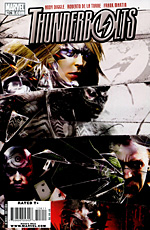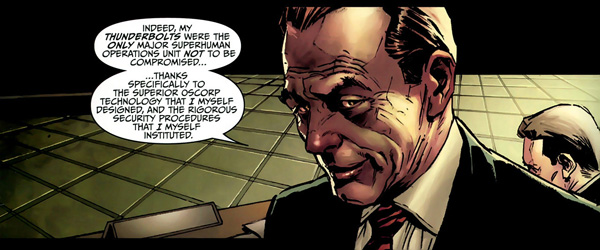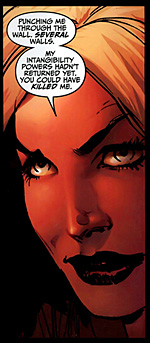 Written by Andy Diggle
Written by Andy Diggle
Art by Roberto de la Torre
32 pages, color
Published by Marvel Comics
The last time I read Thunderbolts regularly, the creative team was still Kurt Busiek and Mark Bagley. So while it’s certainly been a while since I’ve checked in on Marvel’s resident team of super-villains, it’s certainly been hard to ignore them. Warren Ellis and Mike Deodato Jr.’s revamp of Thunderbolts was big enough news that I’m certainly familiar with the book’s current status with supervillains forced to work for the government. With the arrival of Andy Diggle and Roberto de la Torre as the new creative team, it sounded like a good a time as any to take a look and see firsthand just how it’s doing.
In the wake of Secret Invasion and the Skrulls’ attempt to take over Earth, the Thunderbolts are smelling like roses. They helped defeat the Skrull war cruisers hovering over Washington DC, and unlike most other super-teams none of their members were revealed to be a Skrull duplicate. In other words, now is the time that Norman Osborn’s been waiting for, with his political moves just waiting to be played. And all that seems to be in his way, now, are a few of the nicer members of the Thunderbolts…

Thunderbolts #126 is in some ways a book-in-transition sort of comic. All of the characters are either re-positioning themselves or being slid across the board by other people, the status for just about everyone involved being changed slightly. There’s a distinct line being drawn across the middle of the team, and everyone’s being forced to pick sides.. What I appreciated about this issue is that Diggle never made me feel like I was confused or left out of what was happening. There’s no dumps of expository information, but his characters none the less are able to get all of the information I need across to me.  And with all that information, I found myself cautiously interested. It’s a nice mix of wanting the nicer characters (Songbird, Radioactive Man, Penance) to survive even as gleefully hoping to see just what the nastier ones (Moonstone, Norman Osborn, Venom, Bullseye) do next. If Diggle can maintain the balance of wanting to see both sides (and honestly, I have no idea where to place Swordsman just yet, and I expect that is deliberate on Diggle’s part) then I think he’s going to have a successful run on Thunderbolts.
And with all that information, I found myself cautiously interested. It’s a nice mix of wanting the nicer characters (Songbird, Radioactive Man, Penance) to survive even as gleefully hoping to see just what the nastier ones (Moonstone, Norman Osborn, Venom, Bullseye) do next. If Diggle can maintain the balance of wanting to see both sides (and honestly, I have no idea where to place Swordsman just yet, and I expect that is deliberate on Diggle’s part) then I think he’s going to have a successful run on Thunderbolts.
De La Torre’s art tells Diggle’s story well enough; it’s a clean, easy-to-follow set of page layouts, and de la Torre’s faces are clearly modeled on real people, giving scenes like the Congressional hearings an added layer of heft. (I do wish that someone had told him that there are in fact two Reflecting Pools in Washington DC, though, so that Osborn doesn’t walk out of the Capitol only to get the wrong one in front of him. Anyone who’s been to DC before can’t help but be distracted by wondering why the Lincoln Memorial was holding Congress.) I really like the way that de la Torre draws Songbird; her expressions at the end of the issue have just the right level of desperation and fear on them, and the early scenes with her talking with Swordsman are really well drawn. Likewise, Moonstone has such a wonderful level of menace on her face as she interviews Penance that it’s hard to not love what de la Torre does with this comic. I’m not as crazy as Frank Martin’s colors in some of the scenes, though; they come across looking just a little too slick and polished, and with the slightly more rough-hewn faces that de la Torre draws, it’s not a perfect match.
Will I read Thunderbolts #127? Probably. This was an entertaining first issue for Diggle and de la Torre, and if nothing else the promise of this initial story being just two issues all but assures that I’ll check out the conclusion. Diggle may have had a tough position to enter the book with—the aftermath of a company-wide cross-over hanging over his head—but he’s doing a good job with it.
